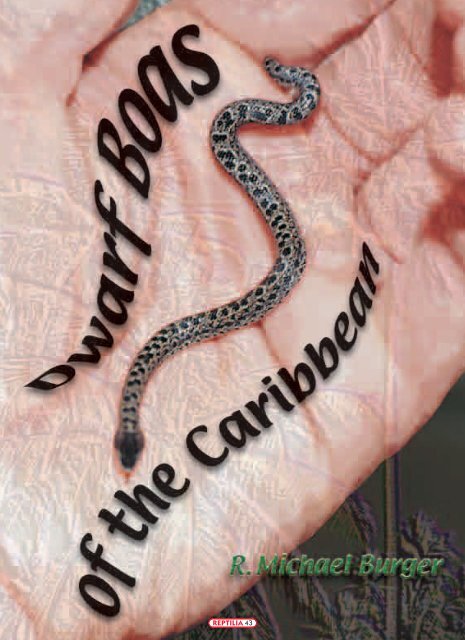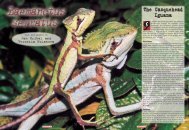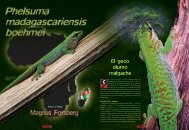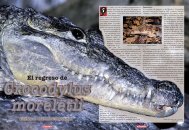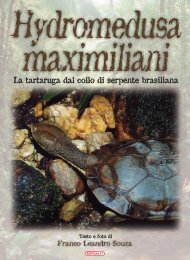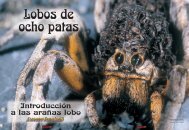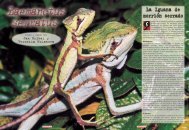Dwarf Boas of the Caribbean - Reptilia
Dwarf Boas of the Caribbean - Reptilia
Dwarf Boas of the Caribbean - Reptilia
Create successful ePaper yourself
Turn your PDF publications into a flip-book with our unique Google optimized e-Paper software.
REPTILIA 43
A South American continental relative <strong>of</strong> <strong>the</strong> island-dwelling Tropidophis, Trachyboa boulengeri feeds on frogs and fish<br />
Imagine relaxing at a<br />
lush <strong>Caribbean</strong> resort,<br />
beneath graceful palms<br />
on white sand beaches.<br />
Fresh seafood and rumspiked<br />
drinks are standard fare.<br />
But <strong>the</strong> most interesting part <strong>of</strong><br />
your tropical island vacation might<br />
be something that <strong>the</strong> travel<br />
brochures didn’t dare to mention …<br />
snakes!<br />
The New World dwarf boas,<br />
Tropidophiidae, are an interesting<br />
lot. Within this family, <strong>the</strong> largest<br />
genus is Tropidophis, popularly<br />
known as <strong>the</strong> dwarf boas, wood<br />
snakes, or “tropes.” Tropidophis,<br />
consists <strong>of</strong> about 20 species, most<br />
found on islands <strong>of</strong> <strong>the</strong> West<br />
Indies, and a few on <strong>the</strong> South<br />
American continent. Ano<strong>the</strong>r genus,<br />
Trachyboa, <strong>the</strong> rough or eyelash<br />
boas, consists <strong>of</strong> only two species<br />
found in northwestern South<br />
America. Two o<strong>the</strong>r genera —<br />
Exiliboa, <strong>the</strong> Oaxacan dwarf boa,<br />
found in sou<strong>the</strong>rn Mexico; and<br />
Ungaliophis, <strong>the</strong> bromeliad or<br />
banana boa, found from sou<strong>the</strong>rn<br />
Mexico to Colombia — have also<br />
been included in this family, but<br />
recent phylogenetic studies suggest<br />
that <strong>the</strong>y are more closely related to<br />
<strong>the</strong> family Boidae.<br />
Distribution and habitat<br />
Species <strong>of</strong> <strong>the</strong> genus Tropidophis<br />
are found on <strong>the</strong> Bahamas, Cuba,<br />
Hispaniola, Turks and Caicos Islands,<br />
Cayman Islands, and Jamaica. In<br />
addition, three species are known<br />
from disjunct locations in South<br />
America. The greatest diversity is<br />
REPTILIA 44<br />
found in Cuba, which is home to at<br />
least 15 species. With <strong>the</strong> current<br />
rate <strong>of</strong> describing new species from<br />
this “hot bed” <strong>of</strong> dwarf boas, <strong>the</strong><br />
total number <strong>of</strong> recognized species<br />
from Cuba alone could easily reach<br />
20 or more.<br />
Considered terrestrial to arboreal<br />
in habit, Tropidophis is found in a<br />
variety <strong>of</strong> natural habitats including<br />
rainforest, swamps, pine woods, and<br />
Neonate Tropidophis feicki are extremely small, but readily feed on geckos (Hemidactylus sp.) in captivity
scrub, as well as in <strong>the</strong> vicinity <strong>of</strong><br />
human habitation. It is usually<br />
found on <strong>the</strong> ground under rocks,<br />
logs, or palm fronds, but has also<br />
been seen among bromeliads in<br />
trees, as high as 10 meters above <strong>the</strong><br />
ground. One record even cites a<br />
dwarf boa found on <strong>the</strong> ro<strong>of</strong> <strong>of</strong> an<br />
outhouse, 2.5 meters above <strong>the</strong><br />
ground.<br />
The sou<strong>the</strong>ast Brazilian dwarf<br />
boa, T. paucisquamis, is believed to<br />
be especially arboreal. It has been<br />
found in trees near streams amid<br />
heavy congregations <strong>of</strong> chorusing<br />
frogs (CROMBIE, pers. comm.).<br />
Several <strong>of</strong> <strong>the</strong> more boldly patterned<br />
Cuban species — such as T.<br />
feicki, T. semicinctus, and T. wrighti<br />
— are especially strong climbers,<br />
and have been reported in trees,<br />
vines, caves, and even on cliff faces.<br />
The holotype specimen <strong>of</strong> T. feicki<br />
was collected in Cuba in a region<br />
full <strong>of</strong> steep-sided wooded hills<br />
called “mogotes” (GEHRMANN,<br />
pers. comm.).<br />
In <strong>the</strong> Bahamas and Jamaica,<br />
dwarf boas are sometimes called<br />
“thunder snakes” or “water snakes,”<br />
possibly because <strong>the</strong>y are frequently<br />
seen after heavy rains, and near<br />
swamps, wells, and water tanks.<br />
Despite <strong>the</strong> relatively small size<br />
and cryptozoic nature <strong>of</strong> dwarf<br />
boas (making <strong>the</strong>m difficult to<br />
find), <strong>the</strong>re is evidence that some<br />
populations may be susceptible to<br />
extirpation. As <strong>the</strong> West Indies<br />
become increasingly accessible to<br />
vacationers, habitat alteration and<br />
destruction becomes an increasing<br />
threat to <strong>the</strong> survival <strong>of</strong> indigenous<br />
wildlife. Introduced feral animals<br />
(e.g., rodents, mongooses, cats, dogs,<br />
and goats) can also have a huge<br />
impact.<br />
One species that is believed to be a<br />
casualty <strong>of</strong> human interference and<br />
introduced species is <strong>the</strong> Navassa<br />
Island dwarf boa, T. bucculentus.<br />
During <strong>the</strong> 1800s, large-scale mining<br />
operations existed on this tiny island<br />
about halfway between Cuba and<br />
Haiti. First described in 1868, T.<br />
bucculentus has not been seen for<br />
100 years or so, and is now believed<br />
to be extinct.<br />
Once grouped with dwarf boas in <strong>the</strong> family Tropidophiidae, <strong>the</strong> bromeliad boa, Ungaliophis continentalis<br />
is now thought to be more closely related to snakes <strong>of</strong> <strong>the</strong> family Boidae<br />
Tropidophis maculatus, a terrestrial species found in western Cuba, is one <strong>of</strong> many<br />
spotted forms <strong>of</strong> dwarf boas<br />
Description<br />
Most dwarf boas average 30–60<br />
centimeters in total length, but some,<br />
such as <strong>the</strong> Cuban T. melanurus, can<br />
attain lengths <strong>of</strong> nearly 1 meter. The<br />
majority <strong>of</strong> species are spotted or<br />
occasionally striped, usually in muted<br />
tones <strong>of</strong> brown, green, or gray. Some<br />
Cuban species, such as T. feicki, are<br />
REPTILIA 45<br />
more attractive, characterized by<br />
alternating black and white bands or<br />
spots. Erythrism, an unusual red or<br />
orange coloration, is known to occasionally<br />
occur in several species.<br />
<strong>Dwarf</strong> boas are capable <strong>of</strong> changing<br />
color between darker and lighter<br />
shades. When <strong>the</strong>y are most active,<br />
generally at night or during <strong>the</strong>
Cuba is home to an amazing array <strong>of</strong> dwarf boas, including several banded<br />
forms such as this Tropidophis fiecki<br />
Tropidophis greenwayi neonates are extraordinarily small<br />
During mating attempts, a Tropidophis haetianus male usually coils its tail<br />
around <strong>the</strong> posterior part <strong>of</strong> <strong>the</strong> female<br />
REPTILIA 46<br />
evening, many species <strong>of</strong> dwarf boas present a lighter<br />
color. During daytime periods <strong>of</strong> inactivity, <strong>the</strong>y present a<br />
darker color. This physiological color change involves <strong>the</strong><br />
movement <strong>of</strong> dark pigment granules, or melanosomes, in<br />
<strong>the</strong> skin: color darkens as melanosomes concentrate near<br />
<strong>the</strong> surface <strong>of</strong> <strong>the</strong> skin; color lightens as melanosomes<br />
move away from <strong>the</strong> surface. This physiological phenomenon<br />
is also seen in o<strong>the</strong>r snake species such as insular boa<br />
constrictors, Boa constrictor imperator.<br />
Defense<br />
<strong>Dwarf</strong> boas display interesting defensive strategies.<br />
They may coil into a tight ball, as seen in several o<strong>the</strong>r<br />
snakes — e.g., ball pythons, Python regius; burrowing<br />
pythons, Charina (=Calabaria) reinhardti; rubber boas,<br />
Charina bottae; and bromeliad boas, Ungaliophis spp.<br />
On Andros Island in <strong>the</strong> Bahamas, <strong>the</strong> local name<br />
“shame snake” may refer to this behavior. Ano<strong>the</strong>r<br />
defensive behavior displayed by species <strong>of</strong> Tropidophis<br />
is more unusual: when disturbed, <strong>the</strong> snake may bleed<br />
from <strong>the</strong> eyes, mouth, and nostrils. I have not witnessed<br />
this auto-hemorrhaging behavior in captive specimens,<br />
but it has been reported in T. canus, T. caymanensis, T.<br />
haetianus, T. melanurus, T. pardalis, T. semicinctus, and<br />
<strong>the</strong> South American T. paucisquamis. Auto-hemorrhaging<br />
is also known in o<strong>the</strong>r reptiles — e.g., horned<br />
lizards, Phrynosoma spp.; long-nosed snakes,<br />
Rhinocheilus locontei; eastern hognose snakes,<br />
Heterodon platyrhinos; and water snakes, Nerodia<br />
erythrogaster. Ano<strong>the</strong>r defensive behavior, which<br />
dwarf boas share with most o<strong>the</strong>r snakes, is <strong>the</strong> emission<br />
<strong>of</strong> an unpleasant-smelling musk.<br />
Diet<br />
In <strong>the</strong> wild, dwarf boas take a variety <strong>of</strong> prey including<br />
lizards (Ameiva, Anolis, Celestus, Leiocephalus, and<br />
Sphaerodactylus) and frogs (Eleu<strong>the</strong>rodactylus, Hyla,<br />
and Osteopilus), as well as small mammals and birds.<br />
These snakes are usually considered active hunters, but<br />
captive observations suggest that <strong>the</strong>y may also hide in<br />
<strong>the</strong> substrate to ambush prey. Many species have a yellow<br />
or orange tail tip reportedly used to lure prey. It has<br />
also been suggested that <strong>the</strong> color <strong>of</strong> <strong>the</strong> tail may be for<br />
discouraging predators.<br />
Captive maintenance<br />
Although <strong>the</strong>y are not <strong>of</strong>ten available in <strong>the</strong> pet trade,<br />
dwarf boas are generally easy to maintain in captivity.<br />
Because <strong>of</strong> <strong>the</strong>ir small size, <strong>the</strong>y do not need large enclosures.<br />
They do need plenty <strong>of</strong> hiding places since <strong>the</strong>y<br />
are shy and secretive. They should be provided pieces <strong>of</strong><br />
cork bark, logs, and branches in addition to several inches<br />
<strong>of</strong> mulch or sphagnum moss substrate to burrow in. A<br />
spill-pro<strong>of</strong> water bowl completes a basic setup.<br />
<strong>Dwarf</strong> boas do well at temperatures <strong>of</strong> 23–29°C<br />
(73–84°F). It is best to provide a temperature gradient<br />
by heating one end <strong>of</strong> <strong>the</strong> enclosure with heat tape or<br />
incandescent light bulbs.
Feeding captive dwarf boas could present a problem.<br />
Being predominantly nocturnal, <strong>the</strong>y are usually easiest<br />
to feed at night under dim light. Larger species such as<br />
<strong>the</strong> Cuban T. melanurus will take rodents, but many <strong>of</strong><br />
<strong>the</strong> smaller species are steadfast lizard feeders. I have<br />
found that some species <strong>of</strong> dwarf boas, such as T.<br />
haetianus, can easily be tricked into taking pinkies. I rub<br />
<strong>the</strong> mouse with a lizard (dead or alive), or a small<br />
amount <strong>of</strong> pulverized lizard “paste,” to give it a lizard<br />
scent. On <strong>the</strong> o<strong>the</strong>r hand, T. greenwayi, which I have<br />
kept and bred, has proved to be an extremely difficult<br />
species to switch over to pinkies. Anoles, Anolis spp.,<br />
and leaf-toed geckos, Hemidactylus spp., are ravenously<br />
devoured by most dwarf boas.<br />
Reproducing Tropidophis is fairly straightforward.<br />
Research has shown that females in <strong>the</strong> wild have a distinctly<br />
seasonal ovarian cycle. I have successfully reproduced<br />
a couple <strong>of</strong> species (T. greenwayi and T. haetianus)<br />
by simply housing small groups toge<strong>the</strong>r year-round, with<br />
minimal temperature fluctuations. However, long-term<br />
captive T. feicki kept toge<strong>the</strong>r year-round did not exhibit<br />
reproductive behavior. Males and females were <strong>the</strong>n separated<br />
and cooled down for a couple <strong>of</strong> months, after<br />
which <strong>the</strong> females were repeatedly placed into <strong>the</strong><br />
male’s enclosure. Within a couple <strong>of</strong> months, both<br />
females were obviously gravid, and each gave birth to a<br />
litter <strong>of</strong> babies about 5 months later. Typical <strong>of</strong> many<br />
snakes, courtship behavior in dwarf boas involves <strong>the</strong><br />
male wrapping <strong>the</strong> posterior third <strong>of</strong> its body in a tight<br />
coil around <strong>the</strong> female. Vigorous courtship bouts may<br />
ensue, with <strong>the</strong> pair tumbling over <strong>the</strong> substrate.<br />
Brood size varies with species. Most give birth to<br />
2–10 <strong>of</strong>fspring, but females <strong>of</strong> larger species, such as T.<br />
melanurus, have been found with up to 36 ova, indicating<br />
that <strong>the</strong>y are capable <strong>of</strong> producing larger broods.<br />
Neonate dwarf boas measure 7.5–20 centimeters in<br />
total length. Feeding small neonates can be especially<br />
challenging. It is best to have a supply <strong>of</strong> small anoles,<br />
geckos, or treefrogs on hand. I have had success feeding<br />
anole limbs and tails (previously frozen to reduce <strong>the</strong><br />
risk <strong>of</strong> parasites) to juvenile dwarf boas, and gradually<br />
moving on to larger food items as <strong>the</strong> snakes grow. In<br />
some species, sexual maturity can be reached in about<br />
15–20 months.<br />
The dwarf boas <strong>of</strong> <strong>the</strong> <strong>Caribbean</strong> are a varied group <strong>of</strong><br />
snakes that have never garnered as much attention from<br />
hobbyists as have <strong>the</strong> larger, more colorful boas <strong>of</strong> <strong>the</strong><br />
family Boidae. Because <strong>of</strong> <strong>the</strong> extremely restricted and<br />
insular distributions <strong>of</strong> dwarf boas, this inattention is probably<br />
a blessing with respect to conservation. It is hoped<br />
that encroachment by humans and introduced feral animals<br />
can be controlled so that future generations will be<br />
able to enjoy this assortment <strong>of</strong> tropical island gems. ■<br />
Acknowledgments<br />
I would like to thank Ronald Crombie and Bill<br />
Gehrmann for sharing <strong>the</strong>ir observations from encounters<br />
with members <strong>of</strong> this genus.<br />
REPTILIA 47<br />
Tropidophis haetianus is a green spotted species found on Haiti and several<br />
<strong>of</strong>fshore islands<br />
Tropidophis greenwayi is found under rocks, leaf litter, and o<strong>the</strong>r debris


